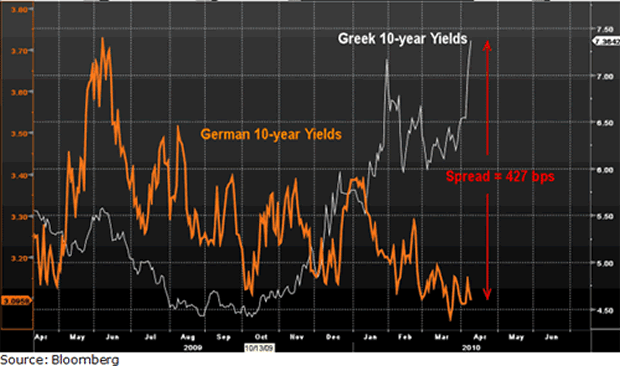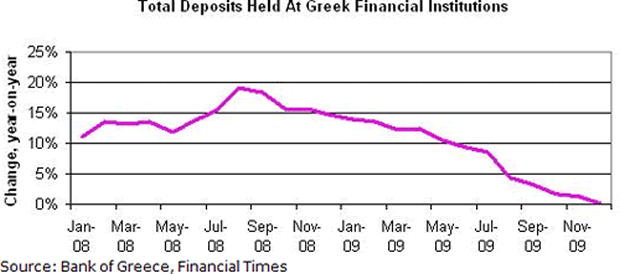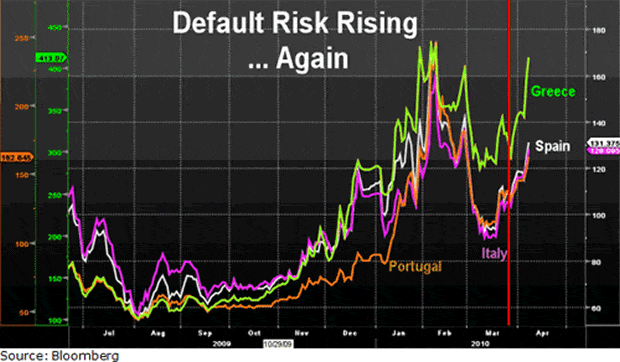Euro Crisis, Greek Bonds Crashing and Capital Flight as Default Risks Soar
Currencies / Euro Apr 11, 2010 - 09:56 AM GMTBy: Bryan_Rich
 It’s been two weeks since the bailout speculation surrounding the Achilles’ heel of the euro zone, Greece, has had some closure.
It’s been two weeks since the bailout speculation surrounding the Achilles’ heel of the euro zone, Greece, has had some closure.
European officials kept the balls in the air as long as they could in an attempt to distract speculators … to manage fears of a Greek and euro-zone crisis. It was a carefully orchestrated game of confusion.
The objective of the game: Tamp down negative sentiment toward Greece’s debt problems and the potential knock-on effect of other weak euro nations, and the resulting selling pressure against the shared currency of those nations — the euro.
As I discussed in my Money and Markets column last week, this game culminated when the political weaponry had been exhausted. The final answer given to the markets: An alleged safety-net for Greece, to be provided in coordination between the euro-zone countries and the IMF.
No surprise, the plan got an obligatory vote of confidence from the heavy hitter politicos in Europe.
Now, for the more meaningful votes, let’s take a look at how the global investment community is receiving this plan …
So far the price activity is sending three, clear warning signals for Greece, for euro-zone countries and for the euro currency. As a result, more impetus is being given to believe the sovereign debt contagion is building.
Warning Signal #1: Greek Bonds Plunging
Greece tested the waters just days after the announced EU/IMF plan, by offering 5 billion euros worth of new bonds to investors. Of course, the Greek government can’t be too deliberate. They have until May 19 to satisfy funding requirements to refinance about 11 billion euros in government bonds. And they need to raise roughly another 20 billion euros by the end of the year.
That precarious position explains why the risk premium for owning Greek debt didn’t subside following the proposed backstop of EU/IMF funds … it rose! And it’s risen sharply since …
Just weeks later the interest rate on 10-year Greek government debt now stands over a full percentage point higher, widening the spread between Greek and German yields to levels not seen since the days Greece was entering the currency union ten years ago.

It’s clear in the chart above that market participants find no security whatsoever in the proposed Emu safety net. Consequently, they’re demanding far higher interest rates to compensate for the risk of owning Greek debt.
And those who were willing to dip their toes in the water and buy Greek debt on March 29, have lost 8 percent in just 12 days.
Warning Signal #2: Capital Fleeing
Last week, Moody’s downgraded the five biggest Greek banks. Since then both the banking sector and the general stock market in Greece have taken it on the chin. In fact, the Greek bank stocks index is down 18 percent and the Greek stock market has fallen 12 percent since March 25, the day of the announced rescue plan.
And given the downtrend in Greek bank deposits from the most recent available data through 2009 (the chart below), it’s a safe bet that deposits have turned sharply negative in 2010 … i.e. capital is moving out of Greece.

Perhaps that’s why Greek banks are said to be turning back to the government for more bailout money earmarked from the 2008 global credit crisis.
Warning Signal #3: Periphery Risk Rising
Now, take a look at this next chart. It shows the market’s perception of sovereign default risk for the weak euro-zone countries. The red line denotes the day the euro zone and IMF announced a rescue plan for Greece.

As you can see, global investors weren’t impressed …
The market activity to the right of the red line shows how markets have responded — pricing in considerably more risk of a default in Greece and a contagion throughout the other problem-laden euro countries since the plan’s announcement.
Rescuer of Last Resort …
Euro-zone officials have continually claimed that Greece is equipped to handle its problems itself. Of course, underplaying the probability that their support could be summoned was likely the spirit of the plan anyway. It’s fair to say, though, that Germany had little interest in being called to action to save Greece from default.
In fact, based on the few details of the plan that have been released, it’s possible that when the official request for capital comes from Greece, the assistance will be vetoed. After all, all sixteen members of the euro-area have to approve a capital injection into Greece.
 |
| Germany has insisted that Greece must pay market interest rates for any bailout loans. |
And Germany has been insistent that if that injection is made, it be made at prevailing market interest rates. As we know those current market rates are already being pushed up to perhaps prohibitively expensive levels for the Greek government.
In short, with Greek’s deadline approaching to roll-over maturing debt, expect the validity of the rescue plan to get tested sooner rather than later.
The Impact on the Euro …
Following suit with the bond market’s vote of no confidence, the currency markets are voting as well. As a result, the euro has resumed its decline following weeks of consolidation.
With the political posturing settled and given the above three warning signals by global markets, it seems likely that the euro is entering the next leg down.
How low can it go?
Technically, the euro has three critical levels ahead: A long-term trendline support just above 1.30, the 2008 low of 1.233, and the 61.8 percent Fibonacci retracement of the euro’s historical high to the historical low — which lies just above 1.12 to the dollar.
Regards,
Bryan
This investment news is brought to you by Money and Markets. Money and Markets is a free daily investment newsletter from Martin D. Weiss and Weiss Research analysts offering the latest investing news and financial insights for the stock market, including tips and advice on investing in gold, energy and oil. Dr. Weiss is a leader in the fields of investing, interest rates, financial safety and economic forecasting. To view archives or subscribe, visit http://www.moneyandmarkets.com.
© 2005-2022 http://www.MarketOracle.co.uk - The Market Oracle is a FREE Daily Financial Markets Analysis & Forecasting online publication.



